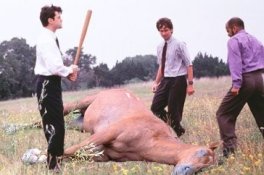If you know what you're doing, you can get accurate exposures by a variety of methods--spot metering, incident metering, or by using the internal meter of another camera. You just need to be aware of what the differences are, and what the strengths and weaknesses of each system are. If what you have now is a LF camera and a DSLR, then you can learn to use it to get consistent exposures for now. In general, I'd prefer to use a handheld meter or even rules of thumb and experience, but if you're the sort of photographer who always has both cameras anyway, then it could be more convenient to use the second camera as a meter.
To the person who said they tried it in the studio and were off, I'd guess it was forgetting bellows factor, because at studio subject distances, bellows factor is an issue with 4x5" and larger, but not with 35mm and smaller outside of macro work. If the exposures were with continuous or available light, there was probably also reciprocity, which doesn't seem to be an issue with digital (or daguerreotypes, interestingly enough).
So if you're using a DSLR (directly, not with an adapter on the view camera back--vignetting from the adapter and mirror box will make this a very limited option) or any meter, you calculate the base exposure, then add filter factor, bellows factor, and reciprocity in that order (as a shortcut, if I'm using the same filtration for many shots, I compensate in the ISO setting on the meter). Remember that with color film, reciprocity may also include small adjustments in filtration.
With a DSLR or other camera, you also need to be aware of some differences that can only be determined by testing, like inaccurate shutter speeds and difference in transmissive light loss between the LF lens and the SLR lens.
Another issue is that a DSLR sensor responds like color slide film, and you've got a lot more range with B&W neg film, so if you are shooting B&W, you'll want to use the spot metering setting on your SLR, if you have that option, to determine the brightness range of the scene, to see if you should adjust your development time to get a neg that prints well. If you don't have spot metering, then make some tests and look at the histogram, and learn how to correlate the histogram of the sensor to the histogram of the film, if you were to take readings with a densitometer and plot it. Don't have a densitometer? Then you make judgments like "if I'm just clipping the highlights and shadows in the histogram on the dslr, maybe I should develop -1" or "if the whole curve fits into 1/3 of the histogram space, I should try +2." You can shoot multiple negs, develop to different times, and test this.
If you're using a DSLR as an exposure meter and shooting color, you can fix the white balance on the DSLR to match the film and also use it as a color meter. Handy, eh?
If you want to use the DSLR as a visualizing tool for B&W filtration, and your camera has a B&W setting, shoot T-Max 100 in your LF camera--the spectral sensitivity is a lot like digital.


 ).
).


